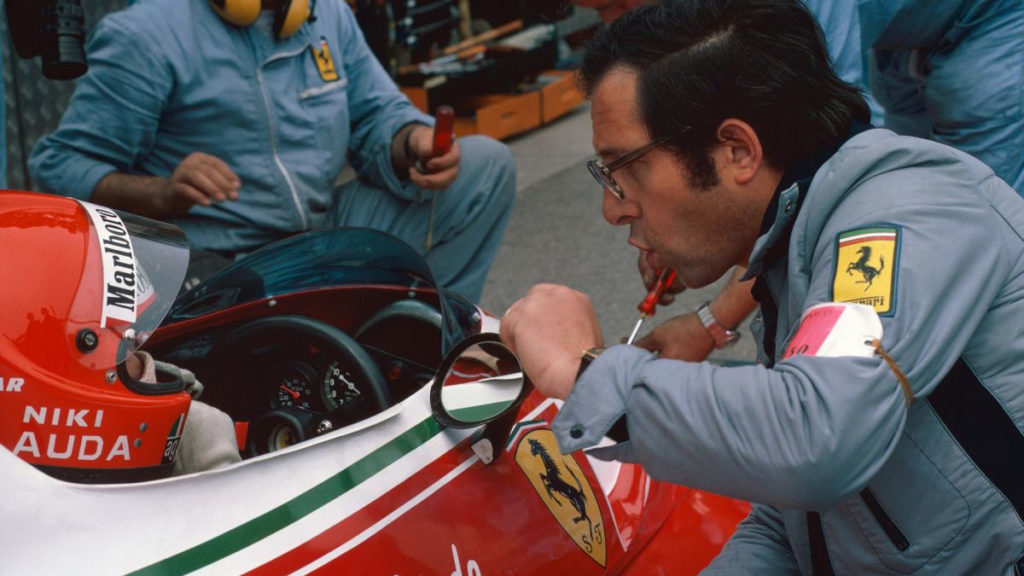In 1962, engineer Mauro Forghieri, at barely 27 years of age, became Technical Director at Ferrari, appointed by Enzo Ferrari in person.
He was to keep this position for the following 25 years, during which time he designed everything possible for a car, from chassis and suspensions, to engines and lines based on aerodynamic studies.
But, his official title aside, Mauro Forghieri fulfilled a series of roles at Ferrari. For example, he was the “Old Man’s” eyes and ears on the racetrack, the confidant of numerous drivers, occasionally the first shoulder cried on by newly widowed girls, and the visionary who helped to keep the company at the cutting edge for almost three decades.
It is worth remembering that, in the Forghieri period, Ferrari was racing everywhere, in F1 and F2 races, hillclimbs, sports competitions, and so on, and that developments on the racing fleet were always quickly transferred to “normal” production Ferraris.
It is also true that he worked in a period in which, as he readily admits, everything was easier. With far fewer people involved, he was always able to “see” the whole project even before it was set down on paper. Although, to him, “working for Ferrari was not a job, it was a question of love”, he certainly put in long hours. He married and had three children, and freely admits that his wife must take most of the credit for raising them. “At Ferrari, holiday time and regular working hours were not a priority!”
After entering Ferrari in 1957, he was given a rather mysterious task. “I didn’t really understand what I was being asked to do, as it didn’t seem to make sense.
Essentially, they wanted me to work on studies for a rear-engined racing car”, says Forghieri. “Enzo Ferrari, remaining very elusive, probably chose me for this task because I was the newest member of the technical department, and while this meant I was probably the least knowledgeable, and certainly the least experienced, it also meant I had fewer preconceived ideas and therefore “mental barriers” to overcome in order to create something truly revolutionary.
1961 brought the famous “Palace Riot” involving the management team, which led to the firing of all of them. It was this incident that really allowed Forghieri’s career to take off. “It no fun, as Enzo Ferrari got each replacement to personally hand the dismissal letter to his “ex” boss. We “replacements” knew the evening beforehand what was going to happen, and also that the decision was set in stone. When Ferrari planned something like this, there was absolutely no chance of him changing his mind. My first challenge, with Giotto Bizzarrini gone, was to fix the rear suspension of the 250 GTO.
After realizing what the problem was (and I will never cease to be grateful to Willi Mairesse for his perfect report after the tests), I added a Watt link and the job was done! I simply had to retain the original, now absolutely redundant, pair of elliptical leaf springs, because they were included in the homologation papers approved by FIA.”
In 1961 Ferrari won the F1 championship with Phil Hill, but immediately lost ground the following year. “The English team was progressing very fast,” recalls Forghieri, “and our engine now lacked the power necessary to compensate for the disadvantage of having a standard, traditional chassis.
We knew we needed a lighter monocoque, but also that this would take time.” Eventually, in 1964, Ferrari won the F1 World Championship with John Surtess driving a 158, the first single-seater Ferrari built with a monocoque, and it was powered by the 1.5 liter V8 engine designed by Forghieri.
“The late 1960s was a difficult time for us professionally, as we were a small company involved in too many, different, racing series, and fighting to compete with companies like Ford and Porsche.
I was the one who suggested, to Ferrari, that we should focus only on Formula 1. Once this decision was taken, the results came quickly. But in the meantime, I was having to cope with the deaths of Lorenzo (Bandini, May 1967, Monaco) and, one year later, Ludovico (Scarfiotti, June 1968, Germany), two great drivers, but also, to me, two wonderful friends.” The 1970s, on the other hand, starring Niki Lauda and the “T” series of F1 cars, were great years for the company.
Following a string of successes with the new Turbo cars in the early 1980s, in 1987 Forghieri decided to leave Ferrari. Shortly afterwards he started collaborating with Romano Artioli’s Bugatti (based in Campogalliano), on the development of the road car named EB110, and with Lamborghini, on the development of a Formula 1 engine. Several years later, in 1994, he founded his own consulting firm, Oral Engineering, still close to Modena, to provide technical support to racing teams and car manufacturers.
“There were many rumors going round about why Ferrari and I went our separate ways, but in fact there is only one main reason. After 40 years together, I could see that Enzo’s energies were fading fast, and I knew that, given his age — he was nearly 90 —, he was not going to continue heading the racing department for much longer. I simply couldn’t imagine working there but having to report to someone else!
However, I will always owe him a debt of gratitude, because he let me do what I really loved: designing the fastest and most advanced racing cars in the world.”
Massimo Delbò


